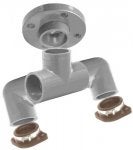CaptainMidnight85 wrote:
Laughing is goood for the soul... :smiler:
I've been wrong before though... once.
So are you one of those engineer guys. :smiler: I met an old friend yesterday, he is an engineer, and one heck of a nice guy.
I simply have to tell you PVC in real world use will not work. That is why the automobile industry uses a nylon thermoplastic.
Other than running over it with a tractor out working in the field , I have built more than several homes. I am quite aware of PVC and its uses, from windows to exterior trim. To whatever.
However PVC is not conducive to heat, it does get brittle, works fine in a window that just sits there with no vibration or stress.
PVC has a great expansion and contraction rate too. About 22 inches per 100 feet if you are looking at say 3 inch pipe. This is quite significant, not so much so with a short section, but still way beyond other materials. Expansion and contraction creates leaks, in the automotive world.
It is not strong in lesser amounts or in less mass units that would be realized in the formation of a inflow fitting for the carb. It will crack at the mounting sooner or later, it will be impossible to keep a secure and tight seal, too much expansion and contraction.
And........if the motor ever does overheat, just one time, best have some gorilla tape along, to tape the carb up to the engine to get home with. Maybe one of those windex bottles would work, fill that with gas and spay a bit into the opening just enough to run it home.

The thermoplastic nylon used for auto applications is tuff, withstands extreme heat, does not expand or contract, and for the most part is satisfactory, but starting to also develop problems in the cracking department from the vibration and what little expansion and contraction that material does have.
What about an aluminum manifold?? Design it and cut it out with CNC milling. What cannot be programmed to that , cut ahead of time on a lathe, punch the holes on a drill press and then turn the laser loose on it and there you go.
I can run the machine but do not have a clue how to write a program for something like this, but should be simple for some one who does this all the time.
Plastic is good under many conditions. but take that material and put it to use under stress, vibration, heat, or where it may have to hold a thread and it will fail. It will crack, break, and in some way not be satisfactory. Even the GM repair shops are finding this out, as any shop you go to there on the trash cart will be a plastic manifold or two.
GM once had a all plastic motor , even tested it. They placed metal alloy sleeves in the cylinders, and bushings and sleeves in the heads, and at the crank ends, and all points of wear and contact.
It never survived due to heat, expansion and contraction.
Keep trying though that is what the mother of invention is all about, I just think quite frankly that a block of hardwood would do better than PVC under this application.
Kit
Edit: There are a great many uses of plastics in the automotive and motorcycle engine applications in use already today, spacers, air boxes, and so on, even gaskets. But they are all some type of thermoplastic. Generally nylon or poly thermoplastic of some kind. Not PVC.





